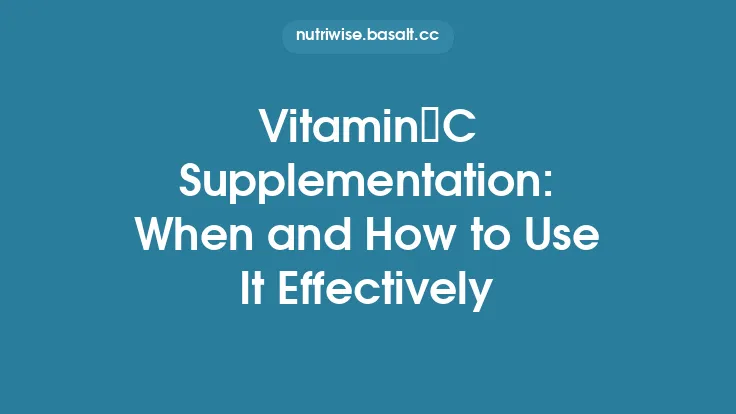When you first encounter the concept of “loading” a supplement, it can feel like a marketing gimmick or a vague recommendation that lacks scientific grounding. In reality, loading phases and subsequent maintenance doses are rooted in pharmacokinetic principles that describe how a substance accumulates in the body, reaches a steady‑state concentration, and eventually plateaus. Understanding these principles allows you to design a supplement regimen that maximizes efficacy while minimizing unnecessary exposure, side‑effects, and waste.
What a Loading Phase Actually Does
A loading phase is a short, intensified period of supplementation intended to bring the target tissue or plasma concentration of a nutrient or ergogenic aid up to its therapeutic or performance‑enhancing level more quickly than would be achieved with a modest daily dose alone. The underlying mechanisms can be summarized as follows:
| Mechanism | Explanation |
|---|---|
| First‑order kinetics | Most nutrients follow first‑order kinetics, meaning the rate of increase in concentration is proportional to the amount still missing to reach the target level. A higher initial dose accelerates this process. |
| Saturation of transporters | Certain compounds rely on carrier proteins or active transporters that become saturated at higher concentrations, allowing rapid intracellular accumulation during a loading window. |
| Enzyme up‑regulation | Some supplements (e.g., creatine) increase the activity of enzymes that facilitate storage (e.g., creatine kinase), and a loading phase can jump‑start this up‑regulation. |
| Receptor priming | For agents that act on receptors (e.g., beta‑alanine’s effect on carnosine synthesis), a brief surge in substrate can prime the system, leading to a quicker functional response. |
The net result is that the body reaches the “effective” concentration in days rather than weeks, which can be crucial for athletes preparing for a competition, patients awaiting therapeutic benefit, or anyone looking to avoid a prolonged period of sub‑optimal dosing.
Typical Loading‑to‑Maintenance Ratios
While each supplement has its own pharmacokinetic profile, a few general patterns have emerged from research and practical experience:
| Supplement | Common Loading Dose | Typical Duration of Loading | Standard Maintenance Dose |
|---|---|---|---|
| Creatine monohydrate | 0.3 g/kg body weight per day (≈20 g for a 70 kg adult) | 5–7 days | 3–5 g per day |
| Beta‑alanine | 4–6 g per day | 4–6 weeks (to saturate muscle carnosine) | 1.2–2 g per day |
| Vitamin C (high‑dose therapeutic) | 2–3 g per day | 3–5 days | 500 mg–1 g per day |
| Magnesium (for athletes) | 400–600 mg elemental Mg²⁺ per day | 7–10 days | 200–300 mg per day |
| Nitrate‑rich beetroot extract | 500 mg nitrate (≈6 mmol) per day | 3–5 days | 200–300 mg nitrate per day |
These ratios are not arbitrary; they reflect the time required for the body’s storage pools (e.g., phosphocreatine, muscle carnosine) to become saturated. Once saturation is achieved, the maintenance dose merely replaces the amount that is naturally turned over or excreted each day.
Calculating Your Personal Loading Dose
If you prefer a more individualized approach rather than relying on generic recommendations, you can use the following formula derived from first‑order kinetics:
\[
\text{Loading Dose (LD)} = \frac{C_{\text{target}} \times V_d}{F}
\]
- \(C_{\text{target}}\) – Desired steady‑state concentration (e.g., 150 mmol/L for intracellular creatine).
- \(V_d\) – Approximate volume of distribution for the supplement (often expressed as a fraction of body weight; for creatine, ~0.6 L/kg).
- \(F\) – Bioavailability factor (the proportion that reaches systemic circulation; for most oral supplements, this is 0.8–0.9).
Once you have the loading dose, the maintenance dose can be estimated by:
\[
\text{Maintenance Dose (MD)} = \text{Clearance} \times C_{\text{target}} \times \frac{1}{F}
\]
- Clearance – The daily rate at which the body eliminates the compound (e.g., creatine clearance ≈ 2 g/day for a typical adult).
These calculations are most useful for supplements with well‑characterized pharmacokinetic data (creatine, beta‑alanine, certain electrolytes). For newer or less studied compounds, it is safer to follow evidence‑based protocols from peer‑reviewed studies.
Why a Maintenance Phase Is Not Optional
Skipping the maintenance phase and stopping after the loading period may seem tempting, especially if you feel the benefits have already manifested. However, the body’s homeostatic mechanisms will gradually deplete the stored pool:
- Turnover Rate – Even “stable” stores like muscle carnosine or phosphocreatine are subject to daily turnover (≈1–2 % per day).
- Excretion – Water‑soluble nutrients are filtered by the kidneys; excess amounts are lost in urine.
- Metabolic Utilization – During exercise or stress, stored compounds are consumed to meet energy demands.
If you discontinue supplementation abruptly, you may experience a regression to baseline levels within a few weeks, eroding the gains you worked to achieve. A well‑designed maintenance dose ensures that the concentration remains within the therapeutic window without unnecessary excess.
Safe Cycling: When and How to Take Breaks
Even with a proper loading‑maintenance regimen, many experts recommend periodic “wash‑out” or “off‑cycle” phases. The rationale includes:
- Preventing Receptor Desensitization – Continuous high‑level exposure can down‑regulate receptors or transporters, diminishing responsiveness over time.
- Assessing True Baseline – A break allows you to gauge whether the supplement is still providing a measurable benefit.
- Reducing Cumulative Toxicity – Some nutrients (e.g., high‑dose vitamin C, magnesium) can accumulate in the kidneys or other tissues if taken indefinitely at high levels.
General Cycling Guidelines
| Supplement | Typical On‑Cycle Length | Recommended Off‑Cycle Length |
|---|---|---|
| Creatine | 8–12 weeks | 4 weeks |
| Beta‑alanine | 12–16 weeks | 2–4 weeks |
| High‑dose Vitamin C | 4–6 weeks | 2 weeks |
| Magnesium (athletic dose) | 6–8 weeks | 1–2 weeks |
| Nitrate (beetroot) | 6 weeks | 1 week |
These intervals are not rigid rules; they can be adjusted based on individual response, training cycles, and professional guidance. The key is to avoid indefinite, uninterrupted high‑dose exposure unless a medical professional explicitly advises otherwise.
Monitoring and Adjusting Your Regimen
A safe supplement cycling plan is not a “set‑and‑forget” protocol. Regular monitoring helps you stay within safe limits and adapt to physiological changes.
| Parameter | How to Measure | Frequency |
|---|---|---|
| Plasma/Serum Levels (e.g., creatine, magnesium) | Blood draw, point‑of‑care testing kits | Every 4–6 weeks during loading, then every 8–12 weeks |
| Urinary Excretion (e.g., nitrate, vitamin C) | 24‑hour urine collection | At the end of loading phase |
| Performance Metrics (e.g., sprint time, VO₂max) | Standardized field tests | Every 4 weeks |
| Side‑Effect Checklist (e.g., GI upset, cramping) | Self‑report questionnaire | Weekly |
| Body Composition (e.g., lean mass) | DXA or bioelectrical impedance | Every 8–12 weeks |
If any parameter drifts outside the expected range—such as a rising serum magnesium level beyond the upper normal limit (≈2.5 mg/dL) or persistent gastrointestinal discomfort—you should reduce the maintenance dose or extend the off‑cycle period.
Special Considerations for Different Populations
While the article avoids deep discussion of age‑specific dosing, a brief note on population nuances is still relevant for safety:
- Athletes vs. Recreational Exercisers – Athletes often have higher turnover rates and may benefit from slightly higher maintenance doses, but they also tend to have more rigorous monitoring protocols.
- Individuals with Renal Impairment – Even “safe” loading doses of creatine or high‑dose vitamin C can increase renal load; a reduced loading phase (e.g., 10 g/day for 3 days) followed by a low maintenance dose (2 g/day) may be advisable, pending medical clearance.
- Pregnant or Lactating Women – Most loading protocols are not recommended; instead, a steady, low‑dose approach aligned with prenatal guidelines should be used.
Practical Step‑by‑Step Blueprint
Below is a concise workflow you can adapt to any supplement that employs a loading‑maintenance strategy:
- Identify the Target Concentration – Review scientific literature to find the plasma or tissue level associated with the desired effect.
- Calculate the Loading Dose – Use the formula provided or adopt a standard protocol from peer‑reviewed studies.
- Set the Loading Duration – Typically 5–10 days for rapid‑uptake compounds; longer (4–6 weeks) for slower‑saturating agents like beta‑alanine.
- Transition to Maintenance – Reduce the dose to the amount that compensates for daily turnover.
- Schedule Off‑Cycle Periods – Plan a wash‑out after 8–12 weeks of continuous use, adjusting based on personal response.
- Monitor – Track blood/urine markers, performance outcomes, and any adverse symptoms.
- Adjust – Tweak the maintenance dose up or down by 10–20 % if markers suggest under‑ or over‑saturation.
- Document – Keep a log of doses, dates, and observations; this data becomes invaluable for future cycles and for discussions with healthcare professionals.
Common Myths Debunked
| Myth | Reality |
|---|---|
| “Loading is only for bodybuilders.” | Loading is a pharmacokinetic tool used across sports, clinical nutrition, and even cognitive enhancement (e.g., high‑dose vitamin C for immune support). |
| “If I skip the loading phase, I’ll never see benefits.” | You will still benefit, but the time to reach effective concentrations will be longer, often 2–3 × the usual period. |
| “More is always better during loading.” | Exceeding the scientifically supported loading dose can increase side‑effects without further accelerating saturation. |
| “Maintenance doses are optional after a successful loading phase.” | Without maintenance, the body’s natural turnover will erode the achieved levels, leading to loss of benefit. |
| “Cycling is only for ‘stacked’ supplements.” | Even single‑agent regimens (e.g., creatine alone) benefit from periodic off‑cycles to maintain receptor sensitivity. |
Final Thoughts
Loading phases and maintenance doses are not marketing fluff; they are evidence‑based strategies that align supplement intake with the body’s kinetic realities. By:
- Understanding the science of saturation and turnover,
- Applying calculated dosing rather than guesswork,
- Incorporating structured on‑ and off‑cycles, and
- Monitoring key physiological markers,
you can harness the full potential of your supplements while safeguarding against overexposure and diminishing returns. Whether you’re an elite athlete fine‑tuning performance, a health‑conscious individual seeking optimal nutrient status, or a clinician guiding patients through therapeutic supplementation, a disciplined loading‑maintenance approach offers a clear, reproducible pathway to safe and effective results.





